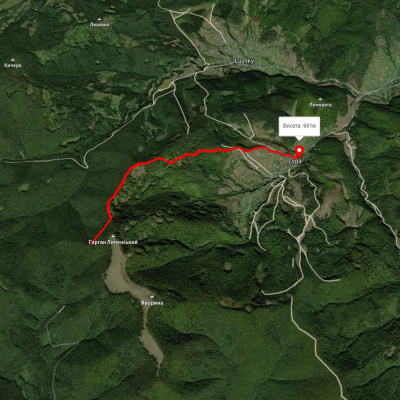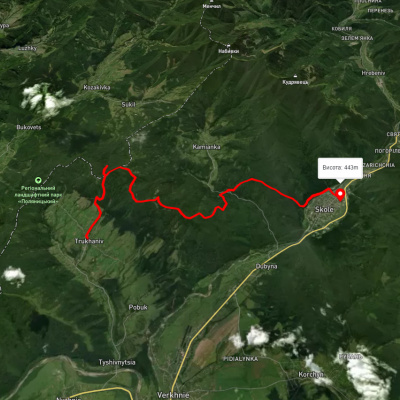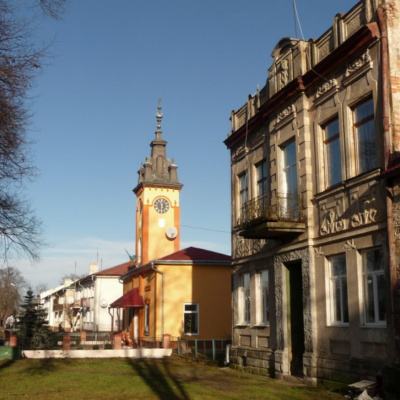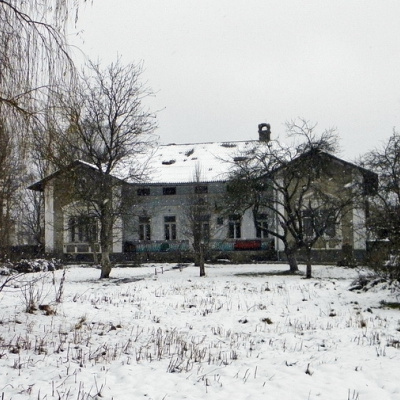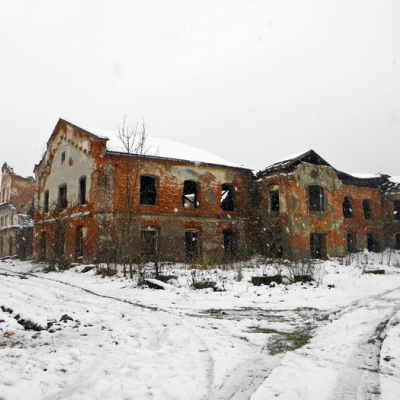Bolekhiv is a city of regional significance in Ukraine, in the
Ivano-Frankivsk region. The territory of the city is 3669 hectares. It is located in the foothills of
the Ukrainian Carpathians (Skole Beskydy massif), on the Sukil River (Dniester basin), on the
Lviv-Chernivtsi highway. There is a railway station. The local government body is the Bolekhiv City Council, bordering on the
Dolyna district.
Bolekhiv received the status of a city of oblast subordination in October 1993, and since then it has been a separate administrative-territorial unit. The Ivano-Frankivsk Regional Council of People's Deputies, by its decision of March 15, 1994, transferred Huziyivka, Kozakivka, Mizhrichanska, Polianytsia, and Tysivska village councils from Dolyna district to the Bolekhiv City Council, and by its decision of September 30, 1994, formed Pidberezhzhia village council with its center in the village of Pidberezhzhia on the territory of the Bolekhiv City Council. The city of Bolekhiv and 11 villages that are part of 6 village councils are subordinated to the Bolekhiv City Council.
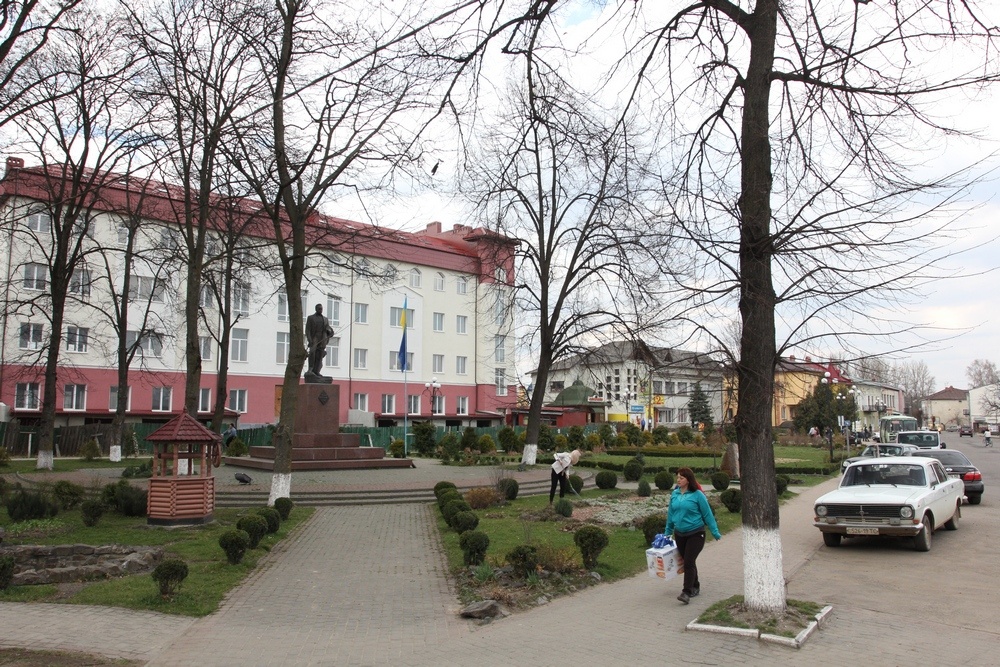
Bolekhiv is ethnographically close to the Boykivshchyna. The area has been inhabited since ancient times, as evidenced by the findings of Bronze Age tools. During the times of Kievan Rus, there was probably an ancient Russian settlement here. The Galicia-Volyn Chronicle of 1238-1239 mentions that one of the contenders for the Galician throne, under the pressure of Prince Danylo Romanovych, "fled to Uhry along the road that goes to Borsukiv Dol, arrived at the bathhouse called Rodna, and from there went to Uhry." The place names of the neighborhood of Bolekhiv, which has long been famous for its salt springs, still include the names Banya and Borsukiv forest. Later, a Vlach settlement appeared on the left bank of the Sukili River, near Bania. Ukrainian source scholar and historiographer A. Petrushevych attributes its emergence to the Vlach migration during the times of the Galicia-Volhynia principality. Other researchers (Kaluzhnytsky and Kadlec) tend to believe that Bolekhiv Volosky was founded in the second half of the 14th century, after the conquest of this territory by Polish kings.
There are several versions about the origin of the town's name, including the most common one from the word "Vlachs": Volokhiv-Bolekhiv. The first written mention of the "Bolekhiv lands" dates back to 1371. Since the 15th century, historical sources refer to Bolekhiv as a settlement formed from two villages - Bolekhiv Voloskyi and Bolekhiv Ruskyi, located on the right bank of the Sukila River. The economic development of Bolekhiv was determined to some extent by the presence of salt deposits here.
In 1546, the first enterprise, a saltworks, was built in Bolekhiv, at the Stara Banya. Wooden fortifications were built at the same time. All this was destroyed to the ground by the Tatars in 1562. The place where the fortified courtyard of the saltworks owner Amalia Hrosovska stood is still known as Hrosivka. In the second half of the sixteenth century, the Bolekhiv villages were taken over by the settler Mykola Hedzinskyi, who arrived here from Poland with a convoy of siege troops. He rebuilt the saltworks, built a castle, and two churches for the nobility and commoners. One of the churches was built of stone, fortified as a fortress, and had secret underground passages leading to the castle.
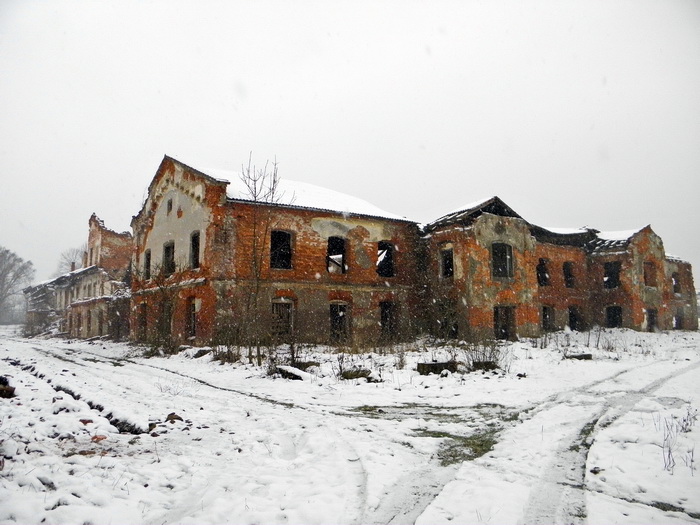
Thanks to the development of trade and crafts in the seventeenth century, Bolekhiv was granted the right of a city. It became one of the military strongholds of the nobility in Prykarpattia. The feudal exploitation of the local population, which had long been engaged in agriculture, animal husbandry, and small-scale cottage industry, intensified. Possessors forced peasants to work on weekdays and holidays. There is a known case when even during the danger of a Tatar attack, they were ordered to sow and haul.
The convenient economic and geographical location of Bolekhiv on the main Carpathian highway contributed to the rapid development of trade in the second half of the seventeenth century. Local merchants maintained trade relations with many cities, resold cattle, sold salt, leather, and other goods. Bolekhiv became a center where moneylenders, tenants, gentry, and other exploiters concentrated.
The cultural life of Bolekhiv at that time was limited only by the activities of the church brotherhood founded in the seventeenth century, which, due to the persecution of Orthodoxy and the strengthening of Uniate, increasingly lost its former functions and in the first quarter of the eighteenth century was limited to church rites.
In the first half of the eighteenth century, a detachment of opryshky led by Ivan Dovbush, the brother of the famous Oleksa, about whom there are many legends, songs, and stories in the Bolekhiv region, operated in the neighborhood adjacent to Bolekhiv. But the most famous and successful campaign of the opryshky to Bolekhiv was the campaign of Ivan Boychuk, which took place on the night of July 6, 1759. On the day of the fair, Boychuk's detachment of about 30 men attacked the town. The raiders burned down some of the houses of the nobility, took away property and jewelry, and distributed them to the poor.
The Gedzinski rule in Bolekhiv ended in the early eighteenth century. The image on the city's coat of arms, as well as other sources, indicate that the noble families of Lubomirski, Poniatowski, Potocki, and others had ownership of certain parts of Bolekhiv. In 1772, Bolekhiv, along with other lands of Eastern Galicia, was conquered by Austria. In 1789, Joachim Potocki was forced to hand over his surrounding lands, including part of Bolekhiv, along with the saltworks, to the Austrian government, which monopolized salt production here. As part of its colonization policy, the Austrian government settled a large group of German settlers in Bolekhiv in 1783-1784. The names Colonia and New Babylon have been preserved to this day.
Large tracts of land, including forests, became state-owned. In 1820, there were 168 dominion morgues, 65 free morgues, and 4482 morgues of peasant lands. Peasants performed serfdom duties, paid chinsh and in-kind tribute. Only 135 peasant households in Ruskyi Bolekhiv received 364 florins and 36 kreutzers of chinsh, 126 cents of oats, and 117 cubits of yarn from the lord's flax and hemp. The peasants worked 4082 days as draft animals and 2843 days on foot as serfs. In addition, there were 34 hovel owners in Bolekhiv who paid only a monetary chinsh of one florin per year. After the abolition of serfdom, residents of the Bolekhiv suburbs did not receive enough land. Compared to 1820, in 1862 the farmers had not much more than 5453 Austrian morgas in total.
When Galicia was conquered by Austria, Bolekhiv lost its importance as a trading town. At the beginning of the nineteenth century, it developed a cottage industry; workshops for the manufacture of nails and hooks, canvas, and leather tanning were established. A brickyard, a brewery, a coal mine, a mill, and a soap factory were built here. In the second half of the nineteenth century, the population of Bolekhiv grew despite difficult living conditions and a number of cholera epidemics. The town had 346 houses and 3796 inhabitants, with 7189 people living in the villages.
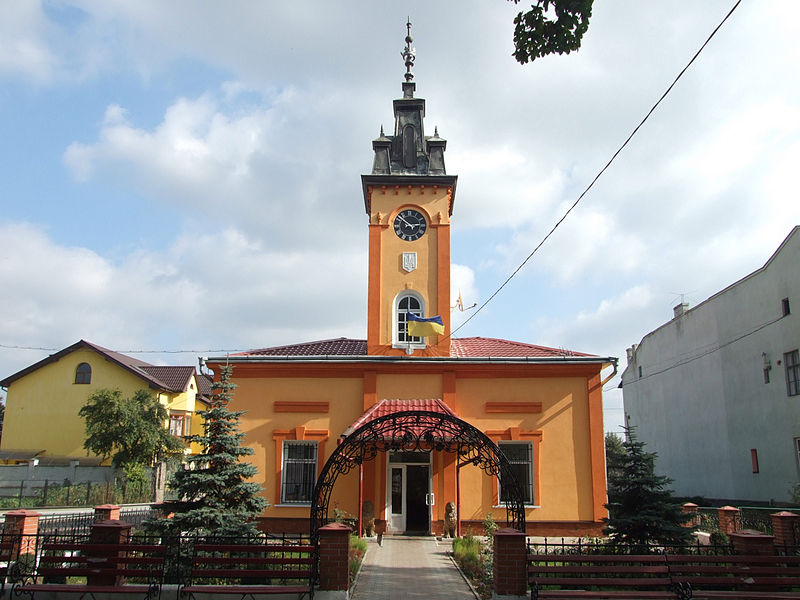
The development of capitalism, which intensified after the reform of 1848, also affected Bolekhiv. Industrial enterprises emerged: a small oil refinery, a match factory, a vinegar factory, a steam mill, oil mills, etc. This was facilitated by the railroad, which became operational in 1873. In the 70s of the XIX century, the Directorate of State Forests and Property was located in Bolekhiv, which founded a school of forestry. At the same time, the city's arboretum of rare tree species was laid out, which has been partially preserved to this day. In the late nineteenth and early twentieth centuries, new enterprises were opened in Bolekhiv: a woodworking and brickyard.
The history of Bolekhiv is closely linked to the names of prominent people who were born, lived, or temporarily stayed in the town. First of all, they include N. I. Kobrynska (1855-1920), a famous Ukrainian writer and public figure, organizer of the women's movement in Prykarpattia. She moved to Bolekhiv in the fall of 1884 and lived here for over 30 years, almost her entire creative life. Many of Kobrynska's works are thematically related to Bolekhiv and its surroundings, namely: "The Merchant's Child," the cycle "War Stories," and fairy tales. In Bolekhiv, the writer prepared for publication a women's almanac called The First Wreath, in which she published the first poems by Lesia Ukrainka and the works of her mother Olena Pchilka. Kobrynska died of typhus on January 22, 1920, and was buried in Bolekhiv at the Voloske Cemetery. On the 40th anniversary of her death, a literary memorial
room-museum of the writer was opened in the local library, which is now an integral part of
the folk museum. One of the streets of the city is named after N.I. Kobrynska.
Ivan Franko was a frequent visitor to Bolekhiv in 1884-1888, in particular, he stayed with his friend, the famous publisher V. Lukych (V. L. Levytskyi). Later, after N. I. Kobrynska moved to Bolekhiv, Franko's circle of acquaintances in the city expanded. He visited the town several times a year with his wife and son Andriy. The Ukrainian geographer H. Velychko, a relative of N. I. Kobrynska, writes in his memoirs that Franko "was partly his own man in Bolekhiv." The writer's old niece, R. O. Babliak, lives in Bolekhiv. Common affairs united N.I. Kobrynska with O.Y. Kobylianska, who often visited Bolekhiv in the 90s of the nineteenth century.
While attending a women's meeting in Stryi, in 1891, E. I. Yaroshynska visited Bolekhiv. In the 1990s, the Czech ethnographer František Rzegorz visited the area, conducting ethnographic research in the vicinity of Stryi and Bolekhiv, in particular, studying the remains of patriarchal families in the village of Tysovi. The famous Ukrainian writer D. Lukianovych worked in Bolekhiv for some time. He left interesting memories of conversations with Ivan Franko and F. Rzegorz, in which they condemned the existing social order.
As a political emigrant from tsarist Russia before the First World War, Ukrainian sculptor M. Havrylko, author of the famous project of the monument to Taras Shevchenko in Kyiv, stayed in Bolekhiv. In the spring of 1911, the residents of Bolekhiv had the opportunity to watch the Hutsul Theater of H. M. Hotkevych, which toured the towns and villages of Galicia. M. I. Pavlyk, his sister Hanna, and other figures who stayed with N. Kobrynska or studied local folklore visited Bolekhiv quite often. In the late nineteenth and early twentieth centuries, Bolekhiv woodcarvers became famous for their skills. V. Vasylevskyi and I. Chmil became famous. The son of the latter, V. Chmil, is now a master of the artistic workshop of the furniture factory.
Relief of Bolekhiv district (mountains, lowlands)
The Precarpathian plain in the Bolekhiv region is hilly, with a generally gentle slope of the surface to the north. The main watershed of the Stryi-Svychivskyi area is relatively narrow and stretches in a submeridional direction. The same Stryi-Svychiv watershed stretches from Bolekhiv in the south to the village of Mizhrichchia in the north. Its maximum elevation reaches 431.2 m (Bolekhivska mountain), 371.5 m (Vedernytsia mountain), and 352.4 m (Oleksychi tract). The lowlands of this watershed are associated with the valley of the Svicha River and its tributaries Sukil and Vilshanka. They are defined by absolute elevations of 330 m in the south and 295 m in the north.
The Outer Carpathians (within Bolekhiv district) are a mountainous region, and its front part is low-lying and relatively calm. There are no sharply defined ridges, mountain peaks, or deeply incised narrow river valleys around - all these relief elements are harmonized here. The maximum height of some mountain peaks does not exceed 800 meters. Thus, Mount Popovtse is 744 m high, Mount Kamianyi Kopets is 534.6 m high.
The southernmost part of the Outer Carpathians is the Beskydy Mountains and belongs to the mid-mountainous region. In orographic terms, it is characterized by distinct monoclinic ridges (Beskydy) or separate sharply separated heights (Gorgany). The relief of this part of the Outer Carpathians exceeds 1000 meters above sea level (Mount Yavorina - 1131.5 m, Mount Bukovets - 1258.1 m; Mount Magura - 1362 meters).
The valley of the Sukil River and its tributaries within the Outer Carpathians are quite narrow and deep, and the rivers themselves are fast-flowing and during floods are full and cause considerable damage (washing away the banks and flooding farmland).
The park is a monument of landscape art of local importance
"Arboretum". Area - 3,0 hectares. Bolekhiv. This is one of the oldest parks in Ivano-Frankivsk region. It was created in Bolekhiv in 1840-1850 (area - 3.0 hectares). Trees were imported from Austrian, German, and Italian nurseries. Some of them were grown from seeds imported from France and North America. Today, most of these trees have survived. These giants are now about one and a half hundred years old. Among the pinwheel trees, it is worth noting the broadleaf larch and Japanese larch, Rumelia pine, western thuja and Canadian thuja. The park is also decorated with a brightly colored golden form of the Lawson cypress.
There are many more deciduous trees here: three-spined gladicia, red oak, Aursic velvet, and green linden. The real curiosities of the park are considered to be the white and fringed carya, each 30 meters high. They originate from North America, where they grow in river valleys along with other deciduous trees.
Part of the park belongs to the territory of the Carpathian Forestry College. The park is home to old trees of European larch, Polish larch, mountain pine, lodgepole pine, common ash, white acacia, warty birch, forest beech, rough elm, bitter chestnut, and European cedar.
The red forms of the forest beech and the sharp-leaved maple are the decoration of the arboretum. Every spring and autumn, the college staff and students plant trees and shrubs in the arboretum. Today, the park is home to young trees of many varieties of magnolia, thuja, juniper, yew, pine, sequoia, eucalyptus, gingo, Amur boxwood, tulip, vinegar trees, and catalpa. Needs restoration and effective protection.
Regional landscape park (RLP)
The area is 1032.0 hectares. Polyanytske forestry, quadrants 9, 10, 14 -16.22 - 26. 0. An original mountain range in terms of geobotany and landscape within the Skole Beskydy. Almost 80% of the territory is occupied by forests: pure beech plantations aged 60 to 160 years; a small share belongs to mixed beech-fir and beech-pine forests, there are several areas of spruce-pine plantations with relict scots pine; fluffy birch is rare. The park is valuable as a recreational and ethno-cultural site.
The park is home to a previously established protected area: the hydrological natural monument of local importance,
Lake Hirske Polianytske (Dead). This is a picturesque mountain lake among forests. It has another name - "Dead". There are several legends about this name. One of them says that when a lord seized the fields of a local landowner, the ground sank and a deep lake was formed in that place. The Dead Lake is of karst origin, located at an altitude of 700 meters above sea level, and has an area of about a hectare. You can have a good rest here, but if you decide to swim, you should be very careful - the lake is 18 meters deep. From the lake, along the stream that flows out of it, a road (4 km - 1.5 hours) leads down to the village of Bukovets.
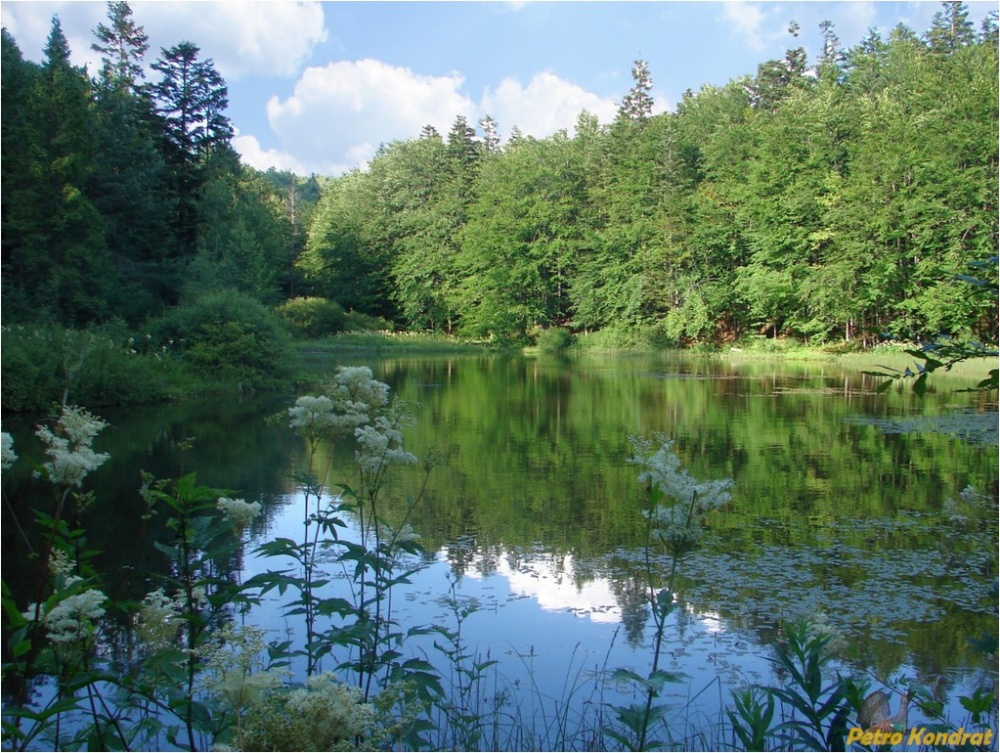
A number of entrepreneurs in the town are engaged in the furniture business, leather goods, etc. The main cultural institution of Bolekhiv is the People's House. It is here that numerous cultural events, celebrations and commemorations of national and local dates, festive events, public holidays, etc. take place; amateur amateur groups also operate here.
There is a municipal Museum of History in Bolekhiv. The Bolekhiv Children's Art School provides aesthetic education and support for artistically gifted children. Libraries that are part of the Bolekhiv Central Library System are the centers of intellectual and cultural communication in the city.
Sights and monuments
- Churches of St. Paraskeva, St. Anna, and the Myrrh-Bearing Wives;
- Roman Catholic Church of the Ascension of the Mother of God;
- remains of a saltworks (mid-19th century);
- Bolekhiv Town Hall (1863);
- Bolekhiv synagogue;
- residential buildings of the late 19th century on Konovaltsia street;
- monument to Ivan Franko;
- monument to Mykhailo Havrylko;
- educational buildings of the technical school (formerly the premises of the court and forest school);
- the protected tract of Vyazyna Bolekhivska.
At Voloske cemetery there are monuments to the victims of World War II; to the grave of N. Kobrynska; a memorial plaque on the house where the writer lived and where I. Franko, O. Kobylyanska, and M. Pavlyk visited.
Nature reserve fund
- Botanical reserves: Magura, Fediv, Shchavnianska Magura;
- Waterfalls: Sukilski waterfalls, Kozachi sllyzy, Kozakivskyi, Polyanitskyi;
- General zoological reserves: Giryava;
- Ornithological reserves: Bursukiv, Pogorelets;
- Protected tracts: Bagno, Basarabka, Bolekhivska Vyazyna, Zelemeniv, Spalenyi Dub, Tanyava-1, Tanyava-2, Tusuly, Chervonyi Beregy;
- Botanical monuments of nature: Larch Alley, Rock Oak, Chapel, Olirky, Padding, Oak Reserve, Camps, Yew Berry, Shchavna;
- Complex natural monuments: Dovbush Rocks (national importance);
- Parks-monuments of landscape art: "Arboretum;
- Regional landscape parks: Polyanitskyi (of national importance).
Bolekhiv City Council, 12 I. Franko Square, +38 (03437) 3-42-52. Telephone number +38 (034) 991-09-11.




